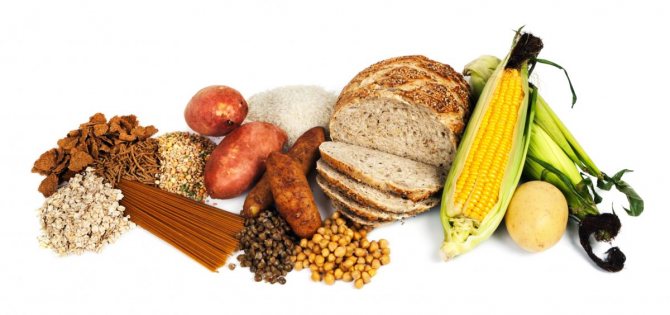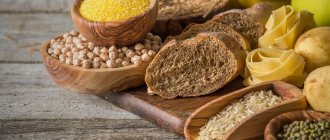What are carbohydrates
It is one of three types of macronutrients, or substances that nourish the body.
The other two are fats and proteins. Carbohydrates are divided into classes:
- Sugars are individual sugar molecules or short chains of such molecules. These are glucose, fructose, galactose, sucrose.
- Starches are long chains of carbohydrate molecules that are broken down into small components in the digestive tract.
- Fiber is carbohydrates that are not digested.
The main function of carbohydrates is to provide energy to the body. Most of them break down in the digestive tract to glucose, which then serves as fuel. Each gram of carbohydrates provides 4 kcal. The exception is fiber, which is much lower in calories.
What to remember: Carbohydrates are nutrients that provide energy.
Why not all carbohydrates are created equal
Figuring out how many carbohydrates you need is not easy because they are different. Most often, carbohydrates are divided into simple and complex. The former include sugars, and the latter include starches and fiber.
But this classification can be problematic because foods high in starch can be both beneficial and harmful to health (especially refined, processed grains).
In addition, sugars act differently Dietary sugars and cardiometabolic risk: systematic review and meta-analyses of randomized controlled trials of the effects on blood pressure and lipids on the body. Sugar that is specifically added to baked goods or drinks is harmful. But natural sugars from fruits and vegetables don't have any health-wrecking effects. So the definitions of complex and simple carbohydrates need to be clarified.
- Complex carbohydrates are carbohydrates from unprocessed foods, including fruits, beans, and whole grains.
- Simple carbohydrates are sugars and starches that have been removed from fiber and processed.
What to remember: Complex carbohydrates are found in unprocessed foods. Simple carbohydrates with less nutritional value are processed.
Low-carb diets and doctors' opinions
According to the US Department of Health's Dietary Guidelines for Americans, a person should get 45-65% of their energy from carbohydrates. If you consume up to 2,000 kcal per day, then the proportion of carbohydrates will be 900-1,300 kcal. When measuring in grams, stick to the norm of 225-325 g per day, although make allowances for age and lifestyle.
Some popular weight loss diets are based on cutting carbohydrates:
- The Atkins or LCHF diet system is low-carbohydrate, high-fat, which means that daily intake is reduced to 20-100 g.
- The keto diet is based on the fact that the proportion of carbohydrates does not exceed 10%. If you consume 2,000 kcal per day, it is acceptable to eat only 20 g of carbohydrates - approximately 1 piece of whole grain bread.
Most nutritionists criticize this approach, insisting that weight loss should be the result of a balanced diet. Jessica Cording, nutritionist and health coach, reminds that a lack of carbohydrates is fraught with the following consequences:
- chronic fatigue;
- irritability;
- constant feeling of hunger;
- constipation
If you adhere to reasonable restrictions, low-carb nutrition systems help you lose weight. In the short term they are effective; however, studies published by the Mayo Clinic showed that after 12-24 months. the result is the same as when following a low-fat diet. But you will improve your health if you exclude ingredients with preservatives and processed carbohydrates from your diet.
What is the difference between carbohydrates
Complex carbohydrates are healthier than simple carbohydrates because they have higher nutrient density. That is, along with every calorie, they supply the body with antioxidants, fiber, vitamins and minerals. But simple carbohydrates are just calories and nothing more.
To understand what the difference is, let’s compare whole grains with refined grains. There are three parts to a whole grain:
- The germ is the part of the grain that is high in polyunsaturated fats and other nutrients.
- Endosperm is the inner part of the grain, which consists mainly of starch.
- The hull is the hard outer part of the grain, which is high in fiber and essential fatty acids.
In the germ and shell (bran) there is everything that is best, healthy and nutritious. But during processing, the shell and embryo are removed, so that only the starchy endosperm remains.
Compare how many nutrients are contained in 120 g of whole and refined wheat grains.
| Whole grain | Refined grain | |
| Calorie content, kcal | 407 | 455 |
| Carbohydrates, g | 87 | 95,4 |
| Proteins, g | 16,4 | 12,9 |
| Fats, g | 2,2 | 1,2 |
| Fiber, g | 14,6 | 3,4 |
| Thiamine, % of daily value | 36 | 10 |
| Riboflavin, % of daily value | 15 | 0 |
| Niacin, % Daily Value | 38 | 8 |
| Vitamin B6, % of daily value | 20 | 8 |
| Folic acid, % of daily value | 13 | 8 |
| Vitamin B5, % of daily value | 12 | 5 |
| Iron, % of daily value | 2 | 8 |
| Magnesium, % of daily value | 41 | 7 |
| Phosphorus,% of daily value | 42 | 13 |
| Potassium, % of daily value | 14 | 4 |
| Zinc, % of daily value | 23 | 6 |
| Manganese, % of daily value | 228 | 43 |
| Selenium, % of daily value | 121 | 61 |
| Choline, mg | 37,4 | 13 |
Whole wheat grain is a source of essential substances that are lost during cleaning and processing.
The same is true with fruits and vegetables. Fresh ones contain sugars, but also vitamins, minerals and fiber. But processed, cooked (especially semi-finished products) and even squeezed vegetables contain more sugar and less nutrients. In addition, sugar is often added to prepared foods and drinks.
What to remember: Complex carbohydrates, such as whole grains and fresh fruits and vegetables, are nutritious.
Simple carbohydrates have more calories but fewer nutrients.
What are the benefits of complex carbohydrates?
Does not cause sudden spikes in blood sugar
Simple carbohydrates are digested quickly, and because of this, blood sugar rises sharply. Jumps in sugar levels cause the pancreas to produce large doses of insulin, and this already leads to a sharp drop in sugar. When there is little of it in the blood, we want to eat again Effects of dietary glycemic index on brain regions related to reward and craving in men - we reach for a new portion of something tasty.
Complex carbohydrates rich in fiber are digested more slowly. Sugars from them enter the blood gradually, which means that jumps do not occur Whole Grains, Legumes, and the Subsequent Meal Effect: Implications for Blood Glucose Control and the Role of Fermentation. Therefore, complex carbohydrates provide energy to the body evenly, helping to keep you feeling full longer.
Reduce the risk of chronic diseases
Complex carbohydrates, when consumed regularly, reduce Association between dietary whole grain intake and risk of mortality: two large prospective studies in US men and women the risk of chronic diseases such as diabetes or cardiovascular disease. All because of the fiber, vitamins and other substances discussed above: they help Critical review: vegetables and fruits in the prevention of chronic diseases in prevention.
Moreover, studies have shown Insoluble carob fiber rich in polyphenols lowers total and LDL cholesterol in hypercholesterolemic sujects that consuming complex carbohydrates reduces the amount of “bad” cholesterol in the blood and increases the amount of “good” cholesterol.
Helps digestion
The intestines are home to billions of beneficial bacteria called microbiota. It affects not only the health of the intestines, but the entire body. Fiber from complex carbohydrates is food for beneficial bacteria. The better you feed them, the better they work, such as producing nutrients like short-chain fatty acids, which are important Review article: prebiotics in the gastrointestinal tract. for the health of the gastrointestinal tract.
Reduce inflammation
Inflammation is the body's natural response to infection or injury. If the process is delayed, it provokes Inflammation, pain, and chronic disease: an integrative approach to treatment and prevention of the development of many serious diseases, including cancer and diabetes.
Complex carbohydrates help fight The effects of diet on inflammation: emphasis on the metabolic syndrome with inflammation, but simple sugars, on the contrary, support it.
Carbohydrates and their importance for the human body
Many people know from the school biology and chemistry curriculum that without carbohydrates, none of the metabolic processes in cellular and tissue structures takes place. Metabolic processes are disrupted because organs begin to use fat reserves to produce energy, causing increased breakdown. The production of ketones accelerates, causing acidification of the internal environment of the body, and poisoning of brain tissue occurs.

Carbohydrates
Carbohydrates have a complex effect on the human body:
- support the proper functioning of the liver and metabolism;
- stimulate gastric peristalsis;
- absorb and remove harmful cholesterol;
- replenish the body with minerals and vitamins;
- ensure uninterrupted supply of sugar to the brain and blood;
- strengthen the immune system;
- reduce signs of premenstrual syndrome in women;
- increase the production of the joy hormone;
- prevent the development of oncology in the walls of the intestines and stomach.
Why are simple carbohydrates harmful?
To be healthy, eat little complex carbohydrates. We must also give up simple ones, because they:
- Provoke overeating. Simple carbohydrates are quickly digested and lead to spikes in blood sugar levels. This causes a constant feeling of hunger.
- Increase the risk of heart attacks and strokes. Studies have shown the Potential role of sugar (fructose) in the epidemic of hypertension, obesity and the metabolic syndrome, diabetes, kidney disease, and cardiovascular disease, that people who frequently eat simple carbohydrates are more likely to develop heart and vascular diseases.
- Increases the risk of developing type 2 diabetes. Frequent consumption of simple carbohydrates can Fructose, insulin resistance, and metabolic dyslipidemia make cells resistant to the action of insulin. This is the cause of the development of type 2 diabetes.
- Lead to sugar addiction. Sugar stimulates the brain to produce dopamine. People who are prone to addictions can become addicted to sweets.
- Increase weight. Simple carbohydrates affect the level of hormones responsible for appetite, and in such a way that the risk of obesity increases. High glycemic index foods, overeating, and obesity.
Classification, properties and functions of carbohydrates
Types of fats
Additional Information! Carbohydrates are divided into simple, easily digestible and complex, which are part of natural products.
What are the types of carbohydrates that produce energy in the body? According to the classification, carbohydrates are distinguished: monosaccharides, disaccharides, polysaccharides, glycogen.
Types of carbohydrate monosaccharides:
- Glucose (a colorless, sweet monosaccharide) that is part of every carbon chain and blood. This is a source of energy that nourishes the liver, heart, and brain. Contained in large quantities in bananas, apples, peaches, grapes, persimmons, and natural fruit juices;
- Fructose is converted into glycogen much faster, unlike glucose, but is slowly absorbed into the intestinal walls, does not lead to an oversaturation of blood sugar, and does not require a large replenishment of the body with sweet foods (honey, berries, fruits);
- Galactose is converted into digestible glucose in liver cells. Forms lactose and milk sugar when interacting with glucose. Not found in free form.
Types of disaccharides:
- Soluble sucrose, which is broken down in the body into fructose and lactose. May be found in berries, fruits, maple syrup, cane, sugar beets;
- Lactose is a carbohydrate found in dairy products. But in case of intolerance, it can cause stomach upset and digestive disorders;
- Maltose is an easily digestible malt sugar formed by combining 2 molecules. It is formed during the breakdown of starch during digestion, in the case of enzymatic breakdown of glycogen in the body. There is a lot of maltose in yeast, beer, cereals, and sprouted wheat grains.
According to the classification, properties and functions, carbohydrates-polysaccharides are distinguished as follows:

Types of carbohydrates
- Starch - when it enters the gastrointestinal tract, it begins to break down, turning into digestible glucose. Included in bread, pasta, cereals, potatoes, legumes, rice, wheat;
- Fiber is a complex carbohydrate with a rigid structure, although it is indispensable for digestion in the human body. Normalizes intestinal function, removes waste and toxins. Fruits, vegetables, bran, nuts, and legume seeds can contain fiber;
- Maltodextrin is an intermediate product, highly soluble in water. It is extracted artificially due to the fermentation of the breakdown of plant starch. It is used as a source of energy in gainers, an additive to sports nutrition to give it uniformity and consistency;
- Glycogen, formed from glucose residues. Begins to deposit reserves in the muscles and liver. This is an energy reserve that can compensate for a sudden lack of glucose and quickly mobilize into a source of energy if necessary.
Note! Glycogen is one of the important carbohydrates, the reserve of which in the liver and muscle tissue is 0.4-0.5 g. It is glycogen that regulates blood sugar levels due to its breakdown into glucose in between meals. If this carbohydrate stops entering the body, its reserves will run out in about 18-20 hours. Gradually, the supply will begin to deplete in the liver cells, which will lead to dysfunction of the organ and the deposition of fat.
What to eat and what not to eat
The diet should contain carbohydrates, but only good ones: complex, fresh, unprocessed.
Where to find complex carbohydrates:
- Whole grains: oats, buckwheat, barley.
- Legumes: peas, beans, beans and lentils (not canned).
- Vegetables and fruits: any, preferably fresh or minimally processed.
- Nuts and seeds: hazelnuts, almonds, sunflower seeds, sesame.
Where are simple carbohydrates hidden?
- Sweet drinks: juices, sodas, cocktails, sweet tea and coffee.
- Desserts and sweets.
- White bread made from finely ground wheat flour.
- Pasta: those made from soft wheat.
Complex carbohydrates are more nutritious than simple ones. They have a lot of fiber and nutrients. Therefore, the more often we eat them, the healthier we become. But simple carbohydrates may be tasty, but completely useless and even harmful.
How to make a menu correctly
To properly consume foods with carbohydrates, consider the following:
- Include fruits rich in dietary fiber in your diet. Skip the jam or preserves by freezing them in the summer. Also, do not drink store-bought juices, because they contain added sugar;
- switch to whole grain bread and cereals, as you will receive a complex of useful nutrients;
- Consume dairy products that do not contain sugar or flavorings. Milk, cheese, and homemade yogurt will provide carbohydrates and at the same time serve as sources of protein and calcium. Buy low-fat foods to limit your calorie intake;
- eat more vegetables, legumes, peas, lentils. They are low in fat, but rich in dietary fiber.
The main rule is that you reduce the amount of fast carbohydrates with a glycemic index of more than 40. They are usually found in store-bought products, as proven by studies conducted in the United States by the Department of Health as part of the preparation of dietary recommendations. Sometimes it is enough to give up carbonated drinks, coffee with syrup, desserts and sweets to improve both your figure and your health.
Is it easy for you to stick to proper nutrition? Share your opinion in the comments!











